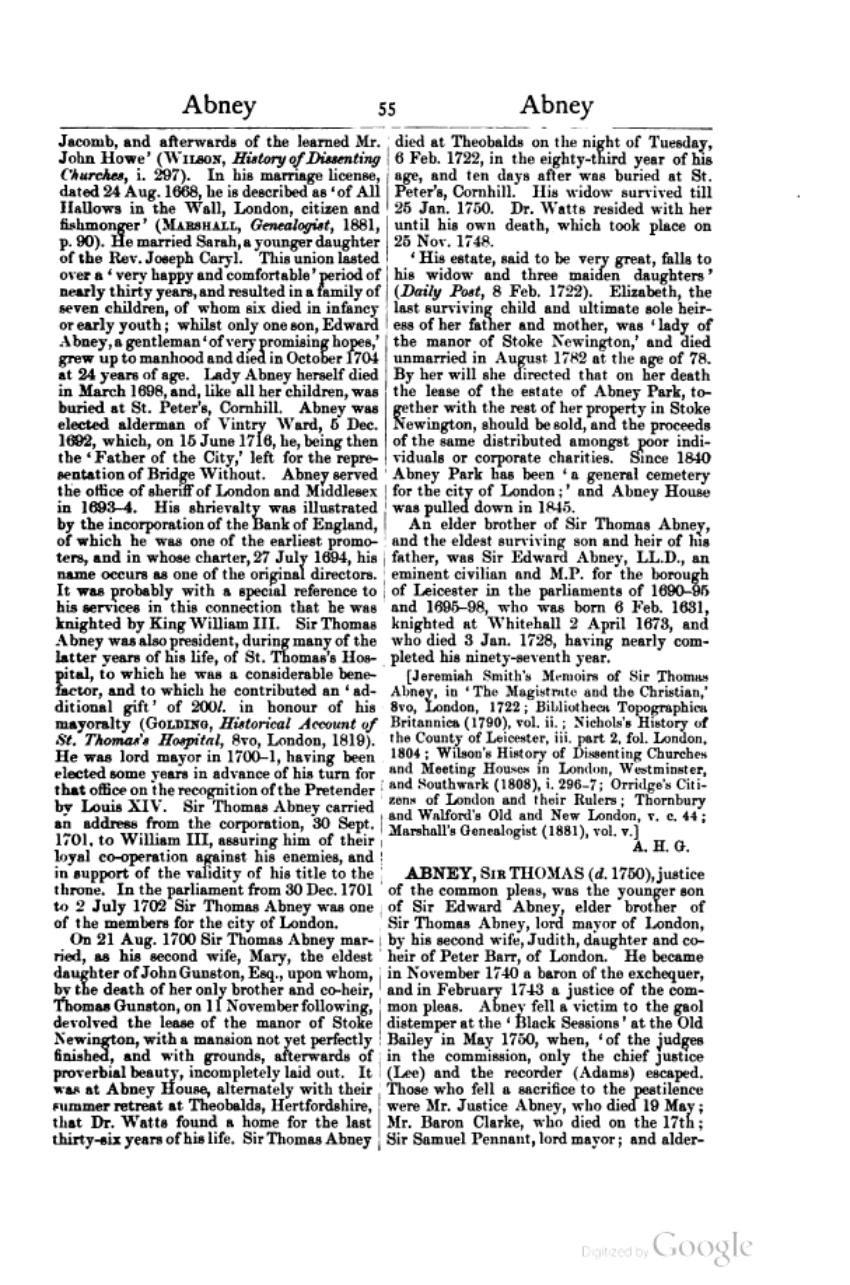Jacomb, and afterwards of the learned Mr. John Howe’ (Wilson, History of Dissenting Churches, i. 297). In his marriage license, dated 24 Aug. 1668, he is described as ‘of All Hallows in the Wall, London, citizen and fishmonger’ (Marshall, Genealogist, 1881, p. 90). He married Sarah, a younger daughter of the Rev. Joseph Caryl. This union lasted over a ‘very happy and comfortable’ period of nearly thirty years, and resulted in a family of seven children, of whom six died in infancy or early youth; whilst only one son, Edward Abney, a gentleman ‘of very promising hopes,’ grew up to manhood and died in October 1704 at 24 years of age. Lady Abney herself died in March 1698, and, like all her children, was buried at St. Peter's, Cornhill. Abney was elected alderman of Vintry Ward, 5 Dec. 1692, which, on 15 June 1716, he, being then the ‘Father of the City,’ left for the representation of Bridge Without. Abney served the office of sheriff of London and Middlesex in 1693–4. His shrievalty was illustrated by the incorporation of the Bank of England, of which he was one of the earliest promoters, and in whose charter, 27 July 1694, his name occurs as one of the original directors. It was probably with a special reference to his services in this connection that he was knighted by King William III. Sir Thomas Abney was also president, during many of the latter years of his life, of St. Thomas's Hospital, to which he was a considerable benefactor, and to which he contributed an ‘additional gift’ of 200l. in honour of his mayoralty (Golding, Historical Account of St. Thomas's Hospital, 8vo, London, 1819). He was lord mayor in 1700–1, having been elected some years in advance of his turn for that office. On the recognition of the Pretender by Louis XIV, Sir Thomas Abney carried an address from the corporation, 30 Sept. 1701, to William III, assuring him of their loyal co-operation against his enemies, and in support of the validity of his title to the throne. In the parliament from 30 Dec. 1701 to 2 July 1702 Sir Thomas Abney was one of the members for the city of London. He was a whig and an unsuccessful candidate for London in 1702.
On 21 Aug. 1700 Sir Thomas Abney married, as his second wife, Mary, the eldest daughter of John Gunston, Esq., upon whom, by the death of her only brother and co-heir, Thomas Gunston, on 11 November following, devolved the lease of the manor of Stoke Newington, with a mansion not yet perfectly finished, and with grounds, afterwards of proverbial beauty, incompletely laid out. It was at Abney House, alternately with their summer retreat at Theobalds, Hertfordshire, that Dr. Watts found a home for the last thirty-six years of his life. Sir Thomas Abney died at Theobalds on the night of Tuesday, 6 Feb. 1722, in the eighty-third year of his age, and ten days after was buried at St. Peter's, Cornhill. His widow survived till 25 Jan. 1750. Dr. Watts resided with her until his own death, which took place on 25 Nov. 1748.
‘His estate, said to be very great, falls to his widow and three maiden daughters’ (Daily Post, 8 Feb. 1722). Elizabeth, the last surviving child and ultimate sole heiress of her father and mother, was ‘lady of the manor of Stoke Newington,’ and died unmarried in August 1782 at the age of 78. By her will she directed that on her death the lease of the estate of Abney Park, together with the rest of her property in Stoke Newington, should be sold, and the proceeds of the same distributed amongst poor individuals or corporate charities. Since 1840 Abney Park has been ‘a general cemetery for the city of London;’ and Abney House was pulled down in 1845.
An elder brother of Sir Thomas Abney, and the eldest surviving son and heir of his father, was Sir Edward Abney, LL.D., an eminent civilian and M.P. for the borough of Leicester in the parliaments of 1690–95 and 1695–98, who was born 6 Feb. 1631, knighted at Whitehall 2 April 1673, and who died 3 Jan. 1728, having nearly completed his ninety-seventh year.
[Jeremiah Smith's Memoirs of Sir Thomas Abney, in ‘The Magistrate and the Christian,’ 8vo, London, 1722; Bibliotheca Topographica Britannica (1790), vol. ii.; Nichols's History of the County of Leicester, iii. part 2, fol. London, 1804; Wilson's History of Dissenting Churches and Meeting Houses in London, Westminster, and Southwark (1808), i. 296–7; Orridge's Citizens of London and their Rulers; Thornbury and Walford's Old and New London, v. c. 44; Marshall's Genealogist (1881), vol. v.]
ABNEY, Sir THOMAS (d. 1750), justice of the common pleas, was the younger son of Sir Edward Abney, elder brother of Sir Thomas Abney [q. v.], lord mayor of London, by his second wife, Judith, daughter and co-heir of Peter Barr, of London. He became K.C. and attorney-general for the duchy of Lancaster in 1733, steward of the Marshalsea court in 1736, in November 1740 a baron of the exchequer, and in February 1743 a justice of the common pleas. Abney fell a victim to the gaol distemper at the ‘Black Sessions’ at the Old Bailey in May 1750, when, ‘of the judges in the commission, only the chief justice (Lee) and the recorder (Adams) escaped. Those who fell a sacrifice to the pestilence were Mr. Justice Abney, who died 19 May; Mr. Baron Clarke, who died on the 17th; Sir Samuel Pennant, lord mayor; and alder-
